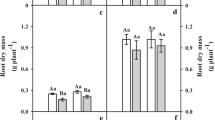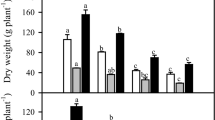Abstract
The aim of this study was to evaluate the effects of elevated CO2 concentration on acclimation mechanisms related to gas exchange, photochemical activity, photorespiration, and oxidative protection in cashew plants exposed to salinity. Thirty-day-old cashew plants were irrigated with nutrient solution without (control) or with supplemental NaCl (100 mM) for 2 weeks in the greenhouse. Afterward, control and salt-stressed plants were transferred to the growth chamber and supplied with atmospheric (380 µmol mol−1) or high CO2 (760 µmol mol−1) concentrations for 15 days. The results show that elevated CO2 alone reduced the CO2 net assimilation rate (PN) without affecting stomatal conductance (gS) and transpiration rate (E), whereas salinity and NaCl + high CO2 reduced the PN associated with a decrease in gS and E. The potential quantum yield of photosystem II (Fv/Fm) was not altered, but a slight reduction in electron transport rate and photochemical quenching (qP) in response to high CO2 alone or combined with NaCl occurred. However, non-photochemical quenching increased due to the effects of high CO2 and NaCl alone and by their combination. High CO2 alleviated the toxic effects of Na+ favoring the K+/Na+ ratio under salinity. High CO2 coupled with salinity decreased glycolate oxidase activity and the contents of hydrogen peroxide (H2O2), NH4+, and glyoxylate. Furthermore, we observed increase in membrane damage associated with increased thiobarbituric acid-reactive substances levels under high CO2. High CO2 also decreased ascorbate peroxidase activity, but did not affect superoxide dismutase activity. In general, our data suggest that high CO2 could induce acclimation processes in plants independent of salinity, revealing a set of responses that are more associated with acclimation than with protective responses.





Similar content being viewed by others
References
Ainsworth EA, Rogers A (2007) The response of photosynthesis and stomacal conductance to rising (CO2): mechanisms and environmental interactions. Plant Cell Environ 30:258–270
Alonso A, Pérez P, Martínez-Carrasco R (2009) Growth in elevated CO2 enhances temperature response of photosynthesis in wheat. Physiol Plant 135:109–120
Aranjuelo I, Irigoyen JJ, Nogués S, Sánchez-Díaz M (2009) Elevated CO2 and water availability effect on gas exchange and nodule development in N2 fixing alfalfa plants. Environ Exp Bot 65:18–26
Baker AL, Tolbert NE (1966) Glycolate oxidase (ferredoxin-containing form). Methods Enzymol 9:339–340
Ball MC, Cochrane M, Rawson HM (1997) Growth and water use of the mangroves Rhizophora apiculate and R. stylosa in response to salinity and humidity under ambient and elevated concentrations of atmospheric CO2. Plant Cell Environ 20:1158–1166
Bowman WD, Strain BR (1987) Interaction between CO2 enrichment and salinity stress in the C4non-halophyte Andropogon glomeratus (Walter) BSP. Plant Cell Environ 10:267–270
Bradford MM (1976) A rapid and sensitive method for the quantitation of microgram quantities of protein utilizing the principle of protein-dye binding. Anal Biochem 72:248–254
Britto DT, Ebrahimi-Ardebili S, Hamam AM, Coskun D, Kronzucker HJ (2010) 42K analysis of sodium-induced potassium efflux in barley: mechanism and relevance to salt tolerance. New Phytol 186:373–384
Cheeseman JM (2006) Hydrogen peroxide concentrations in leaves under natural conditions. J Exp Bot 57:2435–2444
Darbah JNT, Sharkey TD, Calfapietra C, Karnosky DF (2010) Differential response of aspen and birch trees to heat stress under elevated carbon dioxide. Environ Pollut 158:1008–1014
Elliott WH (1953) Isolation of glutamine synthetase and glutamotransferase from green peas. J Biol Chem 201:661–672
Ferreira-Silva SL, Silva EN, Carvalho FEL, Lima CS, Alves FAL, Silveira JAG (2010) Physiological alterations modulated by rootstock and scion combination in cashew under salinity. Sci Hortic 127:39–45
Ferreira-Silva SL, Voigt EL, Silva EN, Maia JM, Fontenele AV, Silveira JAG (2011) High temperature positively modulates oxidative protection in salt-stressed cashew plants. Environ Exp Bot 74:162–170
Flexas J, Ortuño MF, Ribas-Carbo M, Diaz-Espejo A, Fórz-Sarasa D, Medrano H (2007) Mesophyll conductance to CO2 in Arabidopsis thaliana. New Phytol 175:501–511
Foyer CH, Noctor G (2003) Redox sensing and signalling associated with reactive oxygen in chloroplasts, peroxisomes and mitochondria. Physiol Plant 119:355–364
Foyer CH, Bloom AJ, Queval G, Noctor G (2009) Photorespiratory metabolism: genes, mutants, energetics, and redox signaling. Annu Rev Plant Biol 60:455–484
Geissler N, Hussin S, El-Far MMM, Koyro H-W (2015) Elevated atmospheric CO2 concentration leads to different salt resistance mechanisms in a C3 (Chenopodium quinoa) and a C4 (Atriplex nummularia) halophyte. Environ Exp Bot 118:67–77
Gianopolitics CN, Ries SK (1977) Superoxide dismutase occurrence in higher plants. Plant Physiol 59:309–314
Golldack D, Li C, Mohan H, Probst N (2014) Tolerance to drought and salt stress in plants: unraveling the signaling networks. Front Plant Sci 5:1–10
Heath RL, Packer L (1968) Photoperoxidation in isolated chloroplasts. I. Kinetics and stoichiometry of fatty acid peroxidation. Arch Biochem Biophys 125:189–198
Heber U (2002) Irrungen, Wirrungen? The Mehler reaction in relation to cyclic electron transport in C3 plants. Photosynth Res 73:223–231
Hoagland DR, Arnon DI (1950) The water-culture method for growing plants without soil. Calif Agric Exp Sta Circ 347:1–32
Klughammer C, Schreiber U (1994) An improved method, using saturating light pulses, for the determination of photosystem I quantum yield via P700+-absorbance changes at 830 nm. Planta 192(2):261–268
Leakey ADB, Bernacchi CJ, Ort DR, Long SP (2006) Long-term growth of soybean at elevated [CO2] does not cause acclimation of stomatal conductance under fully open air conditions. Plant Cell Environ 29:1794–1800
Lees DH, Francis FJ (1972) Standardization of pigment analyses in cranberries. Hortic Sci 7:83–84
Lichtenthaler HK, Wellburn AR (1983) Determinations of total carotenoids and chlorophyll a and b of leaf extracts in different solvents. Biochem Soc Trans 11:591–592
Lima Neto MC, Cerqueira JVA, Cunha JR, Ribeiro RV, Silveira JAG (2017) Cyclic electron flow, NPQ and photorespiration are crucial for the establishment of young plants of Ricinus communis and Jatropha curcas exposed to drought. Plant Biol 19:650–659
Lima CS, Ferreira-Silva SL, Carvalho FEL, Neto MCL, Aragão RM, Silva EM, Sousa RMJ, Silveira JAG (2018) Antioxidant protection and PSII regulation mitigate photo-oxidative stress induced by drought followed by high light in cashew plants. Environ Exp Bot 149:59–69
Long SP, Ainsworth EA, Rogers A, Ort DR (2004) Rising atmospheric carbon dioxide. Plants FACE the future. Annu Rev Plant Biol 55:591–628
Nakano Y, Asada K (1981) Hydrogen peroxide is scavenged by ascorbate-specific peroxidase in spinach chloroplasts. Plant Cell Physiol 22:867–880
Niazi BH, Athar M, Salim M, Rozema J (2005) Growth and ionic relations of fodderbeet and seabeet under saline environments. Int J Environ Sci Technol 2:113–120
Pérez-López U, Robredo A, Lacuesta M, Munõz-Rueda A, Mena-Petite A (2010) Atmospheric CO2 concentration influences the contributions of osmolyte accumulation and cell wall elasticity to salt tolerance in barley cultivars. J Plant Physiol 167:15–22
Pérez-López U, Robredo A, Lacuesta M, Munõz-Rueda A, Munõz-Rueda A (2012) Elevated CO2 reduces stomatal and metabolic limitations on photosynthesis caused by salinity in Hordeum vulgare. Photosynth Res 111:269–283
Pérez-López U, Robredo A, Miranda-Apodacaa J, Lacuesta M, Munõz-Rueda A, Mena-Petite A (2013) Carbon dioxide enrichment moderates salinity-induced effects on nitrogen acquisition and assimilation and their impact on growth in barley plants. Environ Exp Bot 87:148–158
Pérez-López U, Miranda-Apodaca J, Mena-Petite A, Munoz-Rueda A (2014) Responses of nutrient dynamics in barley seedlings to the interaction of salinity and carbon dioxide enrichment. Environ Exp Bot 99:86–99
Ribeiro RV, Machado EC, Santos MG, Oliveira RF (2009) Photosynthesis and water relations of well-watered orange plants as affected by winter and summer conditions. Photosynthetica 47:215–222
Sharma P, Jha AB, Dubey RS, Pessarakli M (2012) Reactive oxygen species, oxidative damage, and antioxidative defense mechanism in plants under stressful conditions. J Bot 2012:26. https://doi.org/10.1155/2012/217037
Silva EN, Ferreira-Silva SL, Viegas RA, Silveira JAG (2010) The role of organic and inorganic solutes in the osmotic adjustment of drought-stressed Jatropha curcas plants. Environ Exp Bot 69:279–285
Silva EN, Silveira JAG, Rodrigues CRF, Viegas RA (2015) Physiological adjustment to salt stress in Jatropha curcas is associated with accumulation of salt ions, transport and selectivity of K+, osmotic adjustment and K+/Na+ homeostasis. Plant Biol 17:1023–1029
Silveira JAG, Viegas RA, Rocha IMA, Oliveira TJA (2003) Proline accumulation and glutamine synthetase activity are increased by salt-induced proteolysis in cashew leaves. J Plant Physiol 160:115–123
Singh M, Kumar J, Singh S, Singh VP, Prasad SM (2015) Roles of osmoprotectants in improving salinity and drought tolerance in plants: a review. Rev Environ Sci Biotechnol 14:407–426
Souza RP, Ribeiro RV, Machado EC, Oliveira RF, Silveira JAG (2005) Photosynthetic responses of young cashew plants to varying environmental conditions. Pesquisa Agropecuária Brasileira 40:735–744
Thomsen HC, Eriksson D, Møller IS, Schjoerring JK (2014) Cytosolic glutamine synthetase: a target for improvement of crop nitrogen use efficiency? Trends Plant Sci 19:656–663
Xu Z, Jiang Y, Zhou G (2015) Response and adaptation of photosynthesis, respiration, and antioxidant systems to elevated CO2 with environmental stress in plants. Front Plant Sci 6:1–17
Xu Z, Jiang Y, Jia B, Zhou G (2016) Elevated-CO2 response of stomata and its dependence on environmental factors. Front Plant Sci 7:657
Yi C, Yao K, Cai S, Li H, Zhou J, Xia X, Shi K, Yu J, Foyer CH, Zhiou Y (2015) High atmospheric carbon dioxide-dependent alleviation of salt stress is linked to RESPIRATORY BURST OXIDASE 1 (RBOH1)-dependent H2O2 production in tomato (Solanum lycopersicum). J Exp Bot 66:7391–7404
Yu J, Sun L, Fan N, Yang Z, Huang B (2015) Physiological factors involved in positive effects of elevated carbon dioxide concentration on Bermudagrass tolerance to salinity stress. Environ Exp Bot 115:20–27
Acknowledgements
We thank the Conselho Nacional de Desenvolvimento Cientıfico e Tecnológico (CNPq), Fundação Cearense de Apoio ao Desenvolvimento Cientıfico e Tecnológico (FUNCAP) and Grant #2018/04258-6 São Paulo Research Foundation (FAPESP) for financial support, and the Empresa Brasileira de Pesquisa Agropecuária (EMBRAPA) for providing the cashew seeds.
Author information
Authors and Affiliations
Corresponding author
Additional information
Communicated by G. Montanaro.
Publisher's Note
Springer Nature remains neutral with regard to jurisdictional claims in published maps and institutional affiliations.
Rights and permissions
About this article
Cite this article
Souza, N.C.S., Silveira, J.A.G., Silva, E.N. et al. High CO2 favors ionic homeostasis, photoprotection, and lower photorespiration in salt-stressed cashew plants. Acta Physiol Plant 41, 158 (2019). https://doi.org/10.1007/s11738-019-2947-1
Received:
Revised:
Accepted:
Published:
DOI: https://doi.org/10.1007/s11738-019-2947-1




